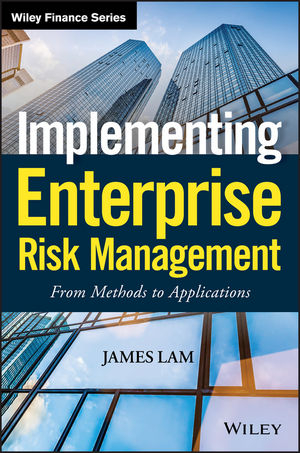
Implementing Enterprise Risk Management
John Wiley & Sons Inc (Verlag)
978-0-471-74519-8 (ISBN)
A practical, real-world guide for implementing enterprise risk management (ERM) programs into your organization Enterprise risk management (ERM) is a complex yet critical issue that all companies must deal with in the twenty-first century. Failure to properly manage risk continues to plague corporations around the world. ERM empowers risk professionals to balance risks with rewards and balance people with processes.
But to master the numerous aspects of enterprise risk management, you must integrate it into the culture and operations of the business. No one knows this better than risk management expert James Lam, and now, with Implementing Enterprise Risk Management: From Methods to Applications, he distills more than thirty years' worth of experience in the field to give risk professionals a clear understanding of how to implement an enterprise risk management program for every business.
Offers valuable insights on solving real-world business problems using ERM
Effectively addresses how to develop specific ERM tools
Contains a significant number of case studies to help with practical implementation of an ERM program
While Enterprise Risk Management: From Incentives to Controls, Second Edition focuses on the "what" of ERM, Implementing Enterprise Risk Management: From Methods to Applications will help you focus on the "how." Together, these two resources can help you meet the enterprise-wide risk management challenge head on—and succeed.
JAMES LAM is president of James Lam & Associates, a risk management consulting firm. He serves on the board of directors of E*TRADE Financial and chairs the Risk Oversight Committee. An NACD Board Leadership Fellow, he is author of the bestselling risk management title, Enterprise Risk Management.
Preface xiii
Acknowledgments xix
Part One ERM in Context
Chapter 1 Fundamental Concepts and Current State 3
Introduction 3
What Is Risk? 4
What Does Risk Look Like? 8
Enterprise Risk Management (ERM) 11
The Case for ERM 13
Where ERM Is Now 18
Where ERM Is Headed 19
Notes 20
Chapter 2 Key Trends and Developments 21
Introduction 21
Lessons Learned from the Financial Crisis 21
The Wheel of Misfortune Revisited 26
Global Adoption 34
Notes 37
Chapter 3 Performance-Based Continuous ERM 41
Introduction 41
Phase Three: Creating Shareholder Value 43
Performance-Based Continuous ERM 44
Case Study: Legacy Technology 56
Notes 59
Chapter 4 Stakeholder Requirements 61
Introduction 61
Stakeholders Defined 62
Managing Stakeholder Value with ERM 79
Implementing a Stakeholder Management Program 80
Appendix A: Reputational Risk Policy 83
Notes 87
Part Two Implementing an ERM Program
Chapter 5 The ERM Project 93
Introduction 93
Barriers to Change 93
Establish the Vision 95
Obtain Buy-In from Internal Stakeholders 97
Assess Current Capabilities against Best Practices 100
Develop a Roadmap 104
Appendix A: ERM Maturity Model 108
Appendix B: Practical Plan for ERM Program Implementation 111
Chapter 6 Risk Culture 115
Introduction 115
Risk Culture Success Factors 117
Best Practice: Risk Escalation 130
Conclusion 130
Notes 131
Chapter 7 The ERM Framework 132
Introduction 132
The Need for an ERM Framework 132
ERM Framework Criteria 136
Current ERM Frameworks 138
An Update: The Continuous ERM Model 145
Developing a Framework 150
Conclusion 153
Notes 153
Part Three Governance Structure and Policies
Chapter 8 The Three Lines of Defense 157
Introduction 157
COSO’s Three Lines of Defense 158
Problems with This Structure 160
The Three Lines of Defense Revisited 164
Bringing It All Together: How the Three Lines Work in Concert 172
Conclusion 173
Notes 173
Chapter 9 Role of the Board 175
Introduction 175
Regulatory Requirements 176
Current Board Practices 179
Case Study: Satyam 180
Three Levers for ERM Oversight 181
Conclusion 189
Notes 189
Chapter 10 The View from the Risk Chair 191
Introduction 191
Turnaround Story 191
The GPA Model in Action 192
Top Priorities for the Risk Oversight Committee 192
Conclusion 196
Notes 197
Chapter 11 Rise of the CRO 198
Introduction 198
History and Rise of the CRO 199
A CRO’s Career Path 201
The CRO’s Role 202
Hiring a CRO 206
A CRO’s Progress 208
Chief Risk Officer Profiles 212
Notes 225
Chapter 12 Risk Appetite Statement 227
Introduction 227
Requirements of a Risk Appetite Statement 228
Developing a Risk Appetite Statement 233
Roles and Responsibilities 239
Monitoring and Reporting 242
Examples of Risk Appetite Statements and Metrics 246
Notes 250
Part Four Risk Assessment and Quantification
Chapter 13 Risk Control Self-Assessments 255
Introduction 255
Risk Assessment: An Overview 255
RCSA Methodology 256
Phase 1: Setting the Foundation 259
Phase 2: Risk Identification, Assessment, and Prioritization 262
Phase 3: Deep Dives, Risk Quantification, and Management 267
Phase 4: Business and ERM Integration 270
ERM and Internal Audit Collaboration 272
Notes 273
Chapter 14 Risk Quantification Models 274
Introduction 274
Market Risk Models 275
Credit Risk Models 278
Operational Risk Models 281
Model Risk Management 283
The Loss/Event Database 288
Early Warning Indicators 289
Model Risk Case Study: AIG 289
Notes 290
Part Five Risk Management
Chapter 15 Strategic Risk Management 295
Introduction 295
The Importance of Strategic Risk 296
Measuring Strategic Risk 299
Managing Strategic Risk 301
Appendix A: Strategic Risk Models 310
Notes 312
Chapter 16 Risk-Based Performance Management 314
Introduction 314
Performance Management and Risk 316
Performance Management and Capital 317
Performance Management and Value Creation 319
Summary 323
Notes 324
Part Six Risk Monitoring and Reporting
Chapter 17 Integration of KPIs and KRIs 327
Introduction 327
What Is an Indicator? 327
Using Key Performance Indicators 329
Building Key Risk Indicators 330
KPI and KRI Program Implementation 335
Best Practices 337
Conclusion 338
Notes 339
Chapter 18 ERM Dashboard Reporting 340
Introduction 340
Traditional Risk Reporting vs. ERM Dashboard Reporting 344
General Dashboard Requirements 348
Implementing ERM Dashboards 351
Avoid Common Mistakes 357
Best Practices 358
Notes 361
Chapter 19 Feedback Loops 362
Introduction 362
What Is a Feedback Loop? 363
Examples of Feedback Loops 364
ERM Performance Feedback Loop 366
Measuring Success with the ERM Scorecard 368
Notes 371
Part Seven Other ERM Resources
Chapter 20 Additional ERM Templates and Outlines 375
Introduction 375
Strategic Risk Assessment 375
CRO Report to the Risk Committee 376
Cybersecurity Risk Appetite and Metrics 378
Model Risk Policy 380
Risk Escalation Policy 382
Notes 385
About the Author 386
Index 387
| Erscheint lt. Verlag | 12.5.2017 |
|---|---|
| Reihe/Serie | Wiley Finance Editions |
| Zusatzinfo | Charts: 0 B&W, 0 Color; Tables: 0 B&W, 0 Color |
| Verlagsort | New York |
| Sprache | englisch |
| Maße | 163 x 231 mm |
| Gewicht | 658 g |
| Themenwelt | Wirtschaft ► Betriebswirtschaft / Management ► Finanzierung |
| ISBN-10 | 0-471-74519-7 / 0471745197 |
| ISBN-13 | 978-0-471-74519-8 / 9780471745198 |
| Zustand | Neuware |
| Informationen gemäß Produktsicherheitsverordnung (GPSR) | |
| Haben Sie eine Frage zum Produkt? |
aus dem Bereich


